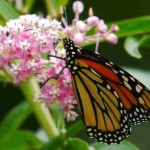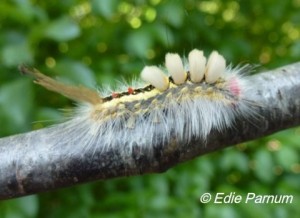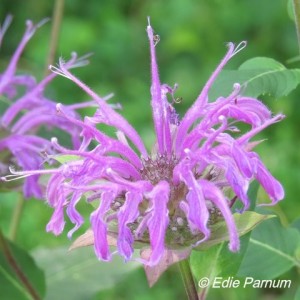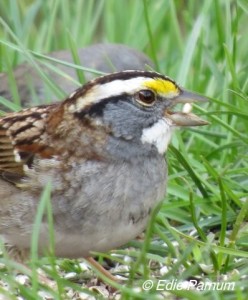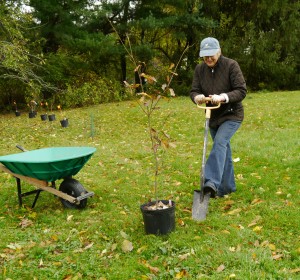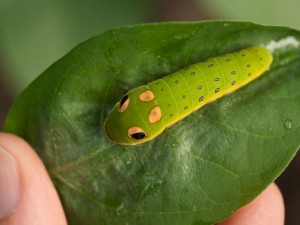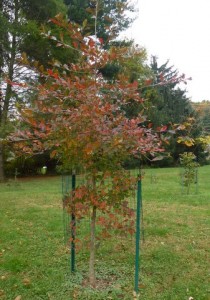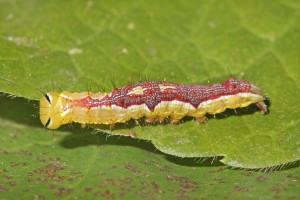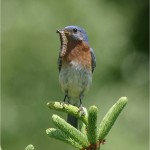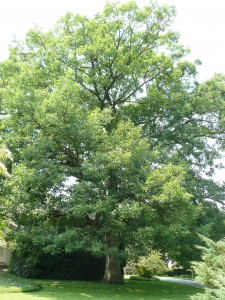By Barb Elliot
The earliest spring flowers will soon emerge. In my garden I’ll admire the delicate white petals of Bloodroot, the first to bloom. Soon I’ll enjoy the blue bell-like flowers of Jacob’s Ladder, the bright yellow of Golden Ragwort, and striking red blooms of Wild Columbine. The flowers are charming, but I will be more captivated by their insect visitors. Small bees and flies will fly from blossom to blossom. Working intently, they will stop briefly to feed and gather nectar and pollen. These will be the first pollinators of the year.
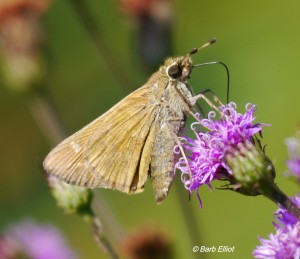
Skipper sipping nectar from Upland Ironweed. @ Barb Elliot
As spring and summer progress, pollinators will visit the succession of blooms on my native trees, shrubs, and perennials. Bees, butterflies, flies, beetles, and wasps will be at work. I’ll watch each butterfly unfurl its straw-like proboscis to daintily probe flower heads and sip nectar. Yellow pollen grains will dot the heads and bodies of bees and flies. Female bees will sport saddlebag-like pollen baskets on their hind legs. The undersides of leafcutter bees’ abdomens will be golden from pollen grains stored on special hairs.
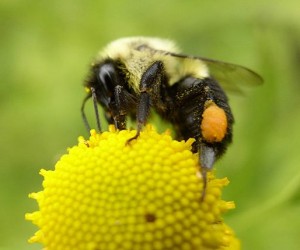
Bumble Bee with pollen baskets. Photo by Beatriz Moisset. Wikimedia Creative Commons.
I’ll notice the size, shape, and tongue lengths of pollinators – characteristics that enable some to better exploit different shaped flowers than others. Iridescent green sweat bees will glisten in the sunlight as they feed on nectar. The strikingly-marked Locust Borer Beetle will catch my attention as it methodically forages for pollen on my goldenrods. I’ll marvel at how close I can get to colorful wasps as they busily collect nectar. Hover flies will hang suspended in air as they take a break from feeding on nectar and pollen. After dark, with my flashlight, I’ll find moths flying from flower to flower, performing nighttime pollination.
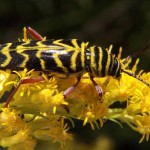
Locust Borer Beetle on goldenrod. Wikimedia Creative Commons photo.
My flowering plants put on their royal finery to entice these pollinators, not me. Their showy colors and patterns advertise and guide the pollinators to the plants’ nectar and pollen. The plants must rely on the pollinators to transport pollen among different flowers of the same species. This cross-pollination enables plants to produce the seeds and fruit needed for reproduction. Well-pollinated plants bear more fruit, produce genetically diverse seed, and are healthier. For the pollinators the nectar provides carbohydrates for energy. The pollen supplies them and their offspring with protein, vitamins, minerals, fats, and starches.
Pollinators play essential roles in our ecosystems. Seventy-five percent of the world’s plants require pollinators to produce seed or fruit. One-third of our food supply comes from pollinator-reliant plants. Birds and other wildlife in my yard and the world over eat
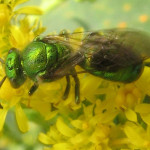
Green Sweat Bee. Photo by Beatriz Moisset on Wikimedia Creative Comoons.
the seeds and fruits produced by pollinator-dependent plants. Pollinators themselves are food for birds and other animals, including insects. A diverse population of pollinators is critical to the web of life.
Unfortunately, many pollinators are in decline. Some are threatened with extinction. Our most beloved pollinator, the Monarch butterfly, is in serious trouble. The eastern U.S. population crashed in 2013, and the smallest number on record over-wintered in Mexico this year. Not only Monarchs but other pollinator populations, including bees, our most prolific pollinators, are in trouble, too. The effects of Colony Collapse Disorder on non-native honeybee populations are well known. However, many of our 4,000 U.S. native bee species, key pollinators of both

Bumble bee with tongue extended on Mountain Mint. Photo @ Barb Elliot.
native plants and crops, are also at risk. Bumble bees seem particularly hard hit, with about half of our 47 U.S. species in decline. Some are in danger of extinction. Less studied pollinators like beetles, wasps, and moths are likely declining as well.
Loss of good foraging and nesting habitat is the primary cause for pollinator declines. Pesticides and introduced parasites add to the toll. Many experts believe neonicotinoid insecticides pose a particular threat to bees and other pollinators. Those that forage on treated plants become weak or die. “Neonics” and other systemic pesticides are taken up through a plant’s roots and travel to all parts of the plant, including its nectar and pollen. Last June, 50,000 bumble bees foraging on flowering trees at a single location in Oregon were killed after the trees were sprayed with a neonicotenoid. Neonics are present in a variety of insecticide brands commonly sold to gardeners. They are also used in nurseries that raise plants. In fact, some plants sold as bee-attractants contain neonicotenoids.
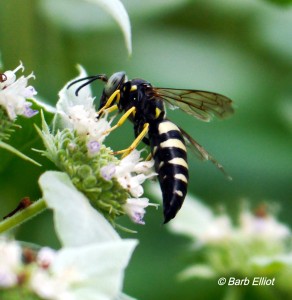
Wasp on Mountain Mint. @ Barb Elliot
Despite all the threats, we gardeners can help sustain pollinator populations in our area. (See table below.) Some gardeners like to attract butterflies, but balk at inviting moths, bees, beetles, flies, and wasps. However, these insects have important roles to play in the web of life and are generally harmless to gardeners. Native bees are unaggressive and rarely sting. Even wasps are docile when foraging on flowers, although they may forcefully defend a nest. By incorporating a variety of native plants in our yards, our most important conservation action, we will attract pollinators that are also predators and keep insect populations in check. Various beetles, flies, and wasps prey on aphids and other insect pests. By growing a diversity of native plants (see plant list below), we will encourage a healthy balance of insects in our gardens.

Hover Fly on Snakeroot. @ Barb Elliot
I hope the plight of the Monarch butterfly will compel us to action. We must help not just the Monarchs* but the less charismatic butterfly, bee, fly, wasp, beetle, and moth pollinators as well. For too long, we have ignored pollinators or treated them as pests to be destroyed. We have gardened for aesthetics and our enjoyment without considering nature. These beneficial creatures are crucial players in the web of life in our own gardens and beyond. We can make a difference for them. We and our gardens will benefit.
*Please note that we will be selling milkweed plants for Monarchs again this year! Stay tuned for an upcoming post about Monarchs and details of the milkweed sale.
How to Help Pollinators
|
Provide Food
|
|
|
¨ A variety of nectar- and pollen-rich native plants. Strive for 8 or more species.
¨ Perennials in clusters, preferably 5 or more of a single species, so plants are easily found.
¨ For a succession of blooms from early spring through late fall.
¨ Natives with different flower shapes for pollinators or varied sizes, shapes, and tongue lengths.
¨ Host plants for butterflies and moths.
|
-
Buy plants at local native plant retailers or where sellers identify whether plants are pre-treated with systemic pesticides such as neonicotinoids.
-
Remove invasive plants so they crowd out natives
|
Provide nesting and overwintering sites
|
|
|
¨ Areas of bare soil in sunny, well-drained spots.
¨ Stumps, logs on the ground, dead branches and trees.
¨ Leaf litter for over-wintering butterflies, moths, beetles and their larvae or pupae
¨ Stems of perennials standing from fall through late winter
|
-
Provide artificial nest sites, e.g., a wooden bee block or a bundle of stems or paper straws. Every 2 years replace or clean with a 3:1 water-bleach solution. Click here for more info.
-
|
Provide water
|
-
Add a shallow dish with sloped sides for easy entry and exit
-
Keep an area of soil moist or muddy for butterflies and other pollinators that forage for minerals and salts in soil
|
Prevent pesticide poisoning
|
-
Don’t use pesticides, but especially avoid neonicotinoids. Click here for a list of common brands containing neonics.
-
Don’t apply herbicides or fungicides to lawn or beds with nest sites or pollinator plants
|
Other Ways to Help Pollinators
|
-
Make a commitment to protect pollinators by getting your yard certified as a pollinator habitat and posting a sign. See The Xerces Society’s “Bring Back the Pollinators” campaign
-
Become a citizen scientist to help scientists track pollinator populations, such as by reporting sightings of bumble bees to Bumble Bee Watch or other species to Project Noah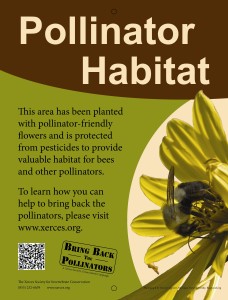
|
| Recommended Native Plants for Pollinators by Bloom Period |
|
Common Name
|
Botanical Name
|
Flower Color
|
Bloom Period^
|
Height
|
Soil
|
Exposure
|
Notes
|
|
Perennials
|
Bloodroot
|
Sanguinaria canadensis
|
White
|
April
|
6-8”
|
Dry to moist
|
Part shade to shade
|
|
Golden Ragwort
|
Packera aurea
|
Yellow
|
April-May
|
1-2’
|
Moist to wet
|
Part shade to shade
|
Host plant. Deer resistant
|
Jacob’s Ladder
|
Polemonium reptans
|
Blue
|
April-May
|
8-15”
|
Moist
|
Part shade to shade
|
Deer resistant
|
Wild Geraniium
|
Geranium maculatum
|
Pink – purple
|
April-May
|
1-3’
|
Moist to dry
|
Part sun to shade
|
Host plant. Deer resistant
|
False Solomon’s Seal
|
Maianthemum racemosum
|
White-cream
|
May
|
12-24”
|
Moist to dry
|
Part shade to shade
|
|
Smooth Solomon’s Seal
|
Polygonatum biflorum
|
White -light yellow
|
May-June
|
2-4’
|
Moist to dry
|
Part sun
|
Deer resistant
|
Wild Columbine
|
Aquilegia canadensis
|
Red
|
May-June
|
1-3’
|
Moist to average
|
Part sun to shade
|
Deer resistant
|
Beardtongue
|
Penstemon digitalis
|
White
|
June-July
|
2-3’
|
Dry to moist
|
Sun to part shade
|
Deer resistant
|
Bee Balm
|
Monarda didyma
|
Red
|
June-August
|
3-4’
|
Moist to dry
|
Sun to part shade
|
Deer resistant
|
Butterfly Milkweed
|
Asclepia tuberosa
|
Orange
|
June-August
|
1-2’
|
Dry to moist
|
Sun
|
Host plant for Monarch, others. Deer resistant
|
Nodding Onion
|
Allium cernuum
|
Pale -dark pink
|
July
|
1-2’
|
Dry to moist
|
Sun
|
Deer resistant
|
Purple Coneflower
|
Echinacea purpurea
|
Purplish pink
|
July
|
3-4’
|
Moist to dry
|
Sun to part sun
|
|
Swamp Milkweed
|
Asclepias incarnata
|
Light – dark pink
|
July
|
3-5’
|
Moist to wet
|
Sun to part sun
|
Host plant – Monarch butterfly; deer resistant
|
Blazing Star
|
Liatris spicata
|
Purple
|
July-August
|
2-4’
|
Moist
|
Sun
|
|
Culver’s Root
|
Veronicastrum virginicum
|
White
|
July-August
|
3-5’
|
Moist
|
Sun to part shade
|
|
Joe Pye Weed
|
Eutrochium maculatum; E. fistulosum
|
Pink
|
July-August
|
4-7’
|
Moist to wet
|
Sun to part shade
|
Host plant. Deer resistant
|
Short-toothed Mountain Mint
|
Pycnanthemum mutucum
|
White
|
July-August
|
2-3’
|
Moist
|
Sun to part shade
|
Deer resistant
|
White Turtlehead
|
Chelone glabra
|
White
|
July-August
|
2-4’
|
Moist to wet
|
Sun to part sun
|
|
Wild Bergamot
|
Monarda fistulosa
|
Pink
|
July-August
|
2-4’
|
Moist to dry
|
Sun to part sun
|
Host plant. Deer resistant
|
Common Boneset
|
Eupatorium perfoliatum
|
White
|
July-September
|
2-4’
|
Moist to wet
|
Sun
|
Host plant
|
Cup Plant
|
Silphium perfoliatum
|
Yellow
|
July- September
|
4-8’
|
Moist to wet
|
Sun
|
Host plant
|
Fragrant Hyssop
|
Agastache foeniculum
|
Blue-violet
|
July-September
|
3-5’
|
Moist to dry
|
Sun to part sun
|
Deer resistant
|
False Sunflower
|
Heliopsis helianthoides
|
Yellow
|
July-September
|
3-5’
|
Moist to dry
|
Sun to part sun
|
|
Garden Phlox
|
Phlox paniculata
|
Pink/white/
lavender
|
July-September
|
2-6’
|
Moist
|
Sun to part shade
|
|
Goldenrod -Stiff
|
Solidago rigida
|
Yellow
|
July-Sept
|
3-5’
|
Dry to moist
|
Sun to part sun
|
Host plant. Deer resistant
|
Great Blue Lobelia
|
Lobelia siphilitica
|
Blue
|
August
|
1-3’
|
Moist to wet
|
Sun to part shade
|
|
Cutleaf/ Green-headed Coneflower
|
Rudbeckia laciniata
|
Yellow
|
August-September
|
3-6’
|
Moist
|
Sun to part sun
|
|
New England Aster
|
Symphotrichum novae-angliae
|
Pink -purple
|
August-September
|
2-5’
|
Moist to wet
|
Sun to part shade
|
Host plant
|
Goldenrod – Zigzag
|
Solidago flexicaulis
|
Yellow
|
August-October
|
1-3’
|
Dry to moist
|
Part shade to shade
|
Host plant. Deer resistant
|
New York Ironweed
|
Vernonia noveboracensis
|
Magenta
|
August-October
|
3-6’
|
Moist to wet
|
Sun to part shade
|
|
Obedient Plant
|
Physostegia virginiana
|
Pink
|
August-October
|
2-5’
|
Moist to wet
|
Sun to part shade
|
|
Mistflower or Hardy Ageratum
|
Conoclinum coelestinum
|
Blue
|
September-October
|
1-3’
|
Moist to wet
|
Sun to part shade
|
Deer resistant
|
|
Vines
|
Virgin’s Bower (a magnet for daytime species & moths at night)
|
Clematis virginiana
|
White
|
August-September
|
To 10’
|
Moist
|
Sun to part shade
|
May spread. Deer resistant
|
|
Trees and Shrubs
|
Pussy Willow
|
Salix discolor
|
Silvery gray
|
March
|
20-35’
|
Sun
|
Wet to moist
|
|
Serviceberry
|
Amelanchier canadensis; A. laevis
|
White
|
April
|
6-20’
|
Sun to part shade
|
Dry to moist
|
|
Highbush Blueberry
|
Vaccinium corymbosum
|
White – pink
|
April-May
|
6-12’
|
Sun to shade
|
Wet to dry, acid
|
|
Redbud
|
Cercis canadensis
|
Pink – lavender
|
April-May
|
20-30’
|
Sun to part shade
|
Moist to wet
|
Deer resistant
|
Black Cherry
|
Prunus serotina
|
White
|
May-June
|
50-75’
|
Sun to part shade
|
Moist
|
|
Sweetbay Magnolia
|
Magnolia virginiana
|
Creamy white
|
May-June
|
10-20’
|
Sun to part shade
|
Moist to wet
|
Deer resistant
|
Black Gum
|
Nyssa sylvatica
|
Green
|
June
|
30-50’
|
Sun to part shade
|
Moist to wet
|
Deer resistant
|
Tulip Tree
|
Liriodendron tulipifera
|
Yellow-green & orange
|
June
|
75-100’
|
Sun to part shade
|
Moist to average
|
|
Basswood
|
Tilia americana
|
Pale yellowish
|
Late June-early July
|
75-100’
|
Full sun to light shade
|
Moist
|
|
Buttonbush
|
Cephalanthus occidentalis
|
Creamy white
|
July-August
|
6-12’
|
Sun
|
Wet to moist
|
|





